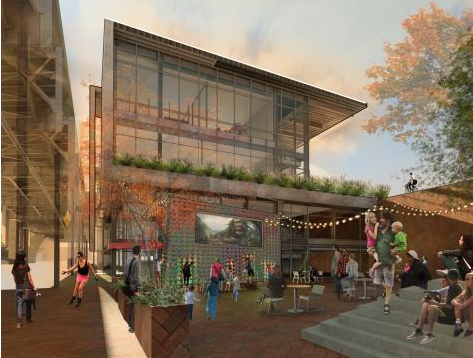A design project conceived by two graduate students from the University of Maryland’s (UMD) Architecture Program has placed in the 2016 AIA COTE Top Ten for Students Design Competition. Graduate students Erin Barkman and Emily Latham’s winning design, entitled, “Creativity Sustaining Community,” delicately integrates a proposed corporate headquarters for Pigmental Animation Studio into the streetscape of Georgetown, boosting both the social and environmental capital of the community. The AIA COTE is the most prestigious sustainability award for students in the field of architecture.
Created by the American Institute of Architects Committee on the Environment (AIA COTE), in partnership with the Association of Collegiate Schools of Architecture (ACSA), the AIA COTE Top 10 for Students challenges architecture students to conceive a project integrating thoughtful design, natural systems and technology solutions that will protect and enhance the environment. The 10 winning submissions, selected by a jury of design professionals, were chosen based on their ability to address 10 specific sustainability measures—from materials to land use—while offering innovative, regenerative strategies.
"We are both thrilled to have been selected,” said Erin Barkman, who is a Path-A graduate student in the architecture program. “We went into this competition confident in the design but not really knowing what would happen. It was very exciting to get that e-mail."
This is the second consecutive year that a team of UMD students have placed in the AIA COTE Top Ten, both the result of work completed in the graduate level ARCH 600 Integrated Design Studio. This year’s course objective centered on a real-world design project for the company Pigmental Animation Studio, who is seeking a community-based, sustainably-minded national headquarters in the Washington, D.C. area. The project was brought to Professor of the Practice Peter Noonan, who led the studio, by ARCH alum, Gensler principal, and Fall 2016 Kea Professor Jordan Goldstein (who is handling the Pigmental project for the firm), as an opportunity for UMD students to inject fresh ideas into the early design stages of visualizing Pigmental’s future home.
The project’s primary challenge was fulfilling the vision of the client; to design an inspirational space that offers multiple connections within the community. Erin and Emily’s concept, which is situated in the vibrant, walkable neighborhood of Georgetown, offers a stimulating work environment that doubles as a community destination. Inside, the building offers abundant light, flexible workspace and features that promote healthy living. Outside, the building façade reflects both the site elevation and the audience; sandwiched between the Whitehurst Freeway to the south and the C&O Canal National Park to north, the building maintains a rigid, reflective exterior facing the Whitehurst and a welcoming, open green space to the south canal. An artistic feature entitled, “Three Figures” is encased in the building’s frame, an interactive, geometric panel system that offers homage to the creative workings of the company. Wrapping areas of the building that are light-sensitive (including a screening room and motion capture studio), the installation is motion-sensitive, creating a whimsical piece of art that reacts to passers-by.
“It’s aspects like this that are the essence of Pigmental,” explained Emily Latham, who is also a Path-A graduate student. “We really wanted to capture this and have it be a part of the actual structure.”
"Integrated and sustainable design is what drives both the profession and this studio at Maryland,” said Professor Noonan. “I am thrilled that for the second consecutive year our student teams have been celebrated and honored at a national level."
The team design will be featured at the American Institute of Architects Annual Convention in Philadelphia this May. This is the second year for the completion. To see the team’s winning design, visit the AIA COTE website here.

